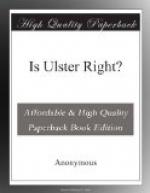that if he had lived at the time of the Union between
Scotland and England, he would have fought against
it; but, living a century later and seeing the benefit
that it had been to his country, his feelings were
all on the other side. That is what the Presbyterians
of Ulster say to-day. They point to the way in
which Ulster has, under the Union, been able to develop
itself; with no richer soil, no better climate, and
no greater natural advantages than other parts of
Ireland, the energy, ability, and true patriotism
of the people have enabled them to establish and encourage
commerce and manufactures which have brought wealth
and prosperity to Ulster whilst the other Provinces
have been stationary or retrograde. There cannot
be a better instance of the different spirit which
animates the two communities than the history of the
linen industry. Michael Davitt bitterly described
it as “Not an Irish, but an Orange industry.”
And from his point of view, he was quite right; for
it is practically confined to Ulster. In that
Province it has during the nineteenth century developed
so steadily that the annual export now exceeds L15,000,000
in value and more than 70,000 hands are employed in
the mills. Not long ago, a Royal Commission was
appointed to enquire whether it was not possible to
grow flax in the south and west, and if so why it
was not done. The Commission made careful enquiries,
and reported that in both Munster and Connaught efforts
had been made to establish the industry (notably by
the late Lord Bandon, one of the much-abused landlord
class, who had let land for the purpose at a nominal
charge, obtained seed and brought experts from the
north to instruct the people); that it had been proved
that both soil and climate were quite as well adapted
for it as in Ulster; but that after a few years the
buyers refused any longer to purchase the flax as it
was so carelessly and badly prepared that it was valueless;
and so the industry had died out. In both south
and west the people expressed their readiness to revive
it if a large grant were made to them by the Government,
but not otherwise.
Then again we may take the growth of the cities.
It seems hard now to realise that one reason why the
people of Dublin opposed the Union was because they
feared lest, when their city ceased to be the capital,
Cork might grow into a great industrial centre and
surpass it. Cork has remained stationary ever
since; Belfast, then an insignificant country town,
has become a city of 400,000 inhabitants, and the
customs from it alone are more than double those from
all the rest of Ireland put together. And what
is true of Belfast is true also on a smaller scale
of all the other towns north of the Boyne.
This remarkable contrast between the progress of the
north-east and the stagnation of the rest of the country
is no new thing. It has been observed ever since
the Union. So long ago as 1832 the Report of the
Commission on the linen manufacture of Ireland contained
the following words:—




